Remaining Useful Life Prediction of an IGBT Module in Electric Vehicles Statistical Analysis
Abstract
1. Introduction
2. IGBT Fault Mechanism Analysis
2.1. Structure of IGBT Module
2.2. Failure Mechanism of IGBT Module
2.2.1. Aluminum Bonding Lead Shedding
2.2.2. Welding Layer Fatigue
3. Life Prediction Model of IGBT Module
3.1. Basic Assumption
3.2. Establishment of IGBT Module Life Acceleration Model
4. Shapiro–Wilk Hypothesis Testing Principle
5. Data Processing and Result Analysis
5.1. Data Analysis of Accelerated Life Experiment
5.1.1. Qualitative Test Analysis
5.1.2. Quantitative Test Analysis
5.2. MLE Double Accelerated Life Estimation
6. Conclusions
- The graph analysis method based on Weibull++ software has fast computation speed, high precision, and good visualization; and the overall performance is better than the traditional computational sketch plotting method.
- The lifetime of the IGBT module is followed by the lognormal distribution, and its acceleration model conforms to the generalized Eyring acceleration model.
- The IGBT RUL can be estimated effectively by the proposed MLE method based on the accelerated life test data.
- This method can provide a certain technical reference for the reliability research of high reliability and long life power electronic devices.
Author Contributions
Funding
Acknowledgments
Conflicts of Interest
References
- Sfakianakis, G.E.; Nawaz, M. Development of a modeling platform for 4.5 kV IGBT power modules. In Proceedings of the IECON 2014—40th Annual Conference of the IEEE Industrial Electronics Society, Dallas, TX, USA, 29 October–1 November 2014; pp. 1416–1422. [Google Scholar] [CrossRef]
- Lu, G.; Zhao, Q.; Xu, Y. Analysis of the electro-thermal parameters variation of the IGBT modules in the power cycle. Fire Control Command Control 2017, 42, 160–163. [Google Scholar]
- Ren, Y.; Peng, Q.; Yu, D.; Zhou, J. Research on the Reliability Prediction Model for IGBT Based on Accelerated Lifetime Testing. Power Electron. 2017, 51, 121–124. [Google Scholar]
- Luo, H.; Li, W.; He, X.; Iannuzzo, F.; Blaabjerg, F. Uneven temperature effect evaluation in high-power IGBT inverter legs and relative test platform design. Microelectron. Reliab. 2017, 76, 123–130. [Google Scholar] [CrossRef]
- Yu, H.; Lu, T.; Ji, S.; Yuan, L.; Zhao, Z. Active clamping circuit threshold voltage design for series-connected HVIGBTs. Proc. CSEE 2016, 36, 1357–1365. [Google Scholar]
- Zhang, P.; Han, R.; Jin, R.; Yu, K.; He, W.; Liu, J. Package Design of High Power IGBT Module for Electric Vehicle. Smart Grid 2014, 2, 48–51. [Google Scholar]
- Jiang, N.; Chen, M.; Xu, S.; Lai, W.; Gao, B. Thermal fatigue of IGBT module considering crack damage. J. Zhejiang Univ. (Eng. Sci.) 2017, 51, 825–833. [Google Scholar]
- Wang, Y.; Jones, S.; Dai, A.; Liu, G. Reliability enhancement by integrated liquid cooling in power IGBT modules for hybrid and electric vehicles. Microelectron. Reliab. 2014, 54, 1911–1915. [Google Scholar] [CrossRef]
- Yang, S.; Xiang, D.; Bryant, A.; Mawby, P. Condition Monitoring for Device Reliability in Power Electronic Converters: A Review. IEEE Trans. Power Electron. 2011, 25, 2734–2752. [Google Scholar] [CrossRef]
- Mi, W.; Yan, Y. Research on reliability of IGBT module. Chin. J. Electron Devices 2015, 38, 27–31. [Google Scholar]
- Zhu, C.; Wang, X.; Luo, H.; Zhou, Y.; Yang, H.; Li, W.; He, X. Dynamical Junction Temperature Online Extraction with Thermal Sensitive Electrical Parameters for High Power IGBT Modules. Proc. CSEE 2017, 37, 2686–2693. [Google Scholar]
- Thebaud, J.M.; Woirgard, E.; Zardini, C.; Azzopardi, S.; Briat, O.; Vinassa, J.M. Strategy for designing accelerated aging tests to evaluate IGBT power modules lifetime in real operation mode. IEEE Trans. Compon. Packag. Technol. 2007, 26, 429–438. [Google Scholar] [CrossRef]
- Mao, Y.; Zhou, L.; Du, X.; Sun, P. Research of IGBT accelerated aging test. Chin. J. Power Sources 2014, 38, 2383–2385. [Google Scholar]
- Zhang, Y.; Li, Z. Research on IGBT Lifetime Prediction Models Based on Accelerated Lifetime Test. Electr. Drive 2016, 46, 72–75. [Google Scholar]
- Zhao, X.; Zhu, G.; Wu, X. Fatigue Life Prediction of Bonding Wires in IGBT Modules Based on Case Temperature. High Volt. Appar. 2017, 53, 167–173. [Google Scholar]
- Lai, W.; Chen, M.; Zhai, L.; Wang, X.; Xu, S. Analysis of IGBT Failure Mechanism Based on Ageing Experiments. Proc. CSEE 2015, 35, 5293–5300. [Google Scholar]
- Lu, Y.; Christou, A. Lifetime Estimation of Insulated Gate Bipolar Transistor Modules Using Two-step Bayesian Estimation. IEEE Trans. Device Mater. Reliab. 2017, 17, 414–421. [Google Scholar] [CrossRef]
- Luo, H.; Iannuzzo, F.; Ma, K.; Blaabjerg, F.; Li, W.; He, X. Active gate driving method for reliability improvement of IGBTs via junction temperature swing reduction. In Proceedings of the 2016 IEEE 7th International Symposium on Power Electronics for Distributed Generation Systems (PEDG), Vancouver, BC, Canada, 27–30 June 2016; pp. 1–7. [Google Scholar] [CrossRef]
- Fang, J.; Liu, X.; Xia, L.; Li, L. Influence of Temperature Field Distribution on Reliability of the Semi-bridge IGBT Device Based on ANSYS and MATLAB. Res Prog. SSE 2018, 38, 178–183. [Google Scholar]
- Choi, U.M.; Blaabjerg, F.; Jørgensen, S. Study on Effect of Junction Temperature Swing Duration on Lifetime of Transfer Molded Power IGBT Modules. IEEE Trans. Power Electron. 2017, 32, 6434–6443. [Google Scholar] [CrossRef]
- Zhou, W.; Wang, X.; Zhang, B.; Lai, W. Research on Failures of Bonding Wire in IGBTs Module. J. Power Supply 2016, 14, 10–17. [Google Scholar]
- Chen, M. Failure characteristics and mechanism analysis of IGBT modules under high-temperature power cycling. J. Xi’an Jiaotong Univ. 2014, 48, 119–126. [Google Scholar]
- Chen, M.; Hu, A.; Liu, B. Failure Mechanism and Lifetime Prediction Modeling of IGBT power electronic devices. J. Xi’an Jiaotong Univ. 2011, 45, 65–71. [Google Scholar]
- Tang, Y.; Wang, B.; Chen, M.; Liu, B. Reliability and on-line evaluation of igbt modules under high temperature. Trans. China Electrotech. Soc. 2014, 29, 17–23. [Google Scholar]
- Park, C.; Padgett, W. Stochastic degradation models with several accelerating variables. IEEE Trans. Reliab. 2006, 55, 379–390. [Google Scholar] [CrossRef]
- Ukponmwan, H.; Ajibade, F. Evaluation of Techniques for Univariate Normality Test Using Monte Carlo Simulation. Am. J. Theor. Appl. Stat. 2017, 6, 51–61. [Google Scholar] [CrossRef]
- Hanusz, Z.; Tarasinska, J. Simulation Study on Improved Shapiro-Wilk Tests for Normality. Commun. Stat.-Simul. Comput. 2014, 43, 2093–2105. [Google Scholar] [CrossRef]
- Torabi, H.; Montazeri, N.; Chávez, A. A test for normality based on the empirical distribution function. SORT 2016, 40, 55–88. [Google Scholar] [CrossRef]
- Mudholkar, G.; Kumarsrivastava, D.; Lin, C. Some p-variate adaptations of the shapiro-wilk test of normality. Commun. Stat. 1995, 24, 953–985. [Google Scholar] [CrossRef]
- Zhou, X.; Wang, X.; Liu, X.; Zhang, L. The Reliability Analysis and the Probability Distribution of Wheel Tracking Test of Asphalt Mixture. In Proceedings of the Geohunan International Conference, Zhangjiajie, China, 6–8 June 2011; pp. 89–96. [Google Scholar] [CrossRef]
- Hanusz, Z.; Tarasińska, J. Normalization of the Kolmogorov–Smirnov and Shapiro–Wilk tests of normality. Biom. Lett. 2015, 52, 85–93. [Google Scholar] [CrossRef]
- Liu, B.; Liu, D.; Tang, Y. Lifetime prediction and failure analysis of IGBT module based on accelerated lifetime test. J. Jiangsu Univ. (Nat. Sci. Ed.) 2013, 34, 556–563. [Google Scholar]
- Glowacz, A.; Glowacz, W.; Kozik, J.; Piech, K.; Gutten, M.; Caesarendra, W.; Liu, H.; Brumercik, F.; Irfan, M.; Khan, Z.F. Detection of deterioration of three-phase induction motor using vibration signals. Meas. Sci. Rev. 2019, 19, 241–249. [Google Scholar] [CrossRef]
- Glowacz, A. Recognition of acoustic signals of commutator motors. Appl. Sci. 2018, 8, 2630. [Google Scholar] [CrossRef]
- Glowacz, A. Fault detection of electric impact drills and coffee grinders using acoustic signals. Sensors 2019, 19, 269. [Google Scholar] [CrossRef] [PubMed]
- Parsons, F.G.; Wirsching, P.H. A Kolmogorov-Smirnov goodness-of-fit test for the two-parameter Weibull distribution when the parameters are estimated from the data. Microelectron. Reliab. 1982, 22, 163–167. [Google Scholar] [CrossRef]
- Lawless, J.F. Statistical Models and Methods for Lifetime Data, 2nd ed.; John Wiley & Sons: New York, NY, USA, 2003. [Google Scholar]
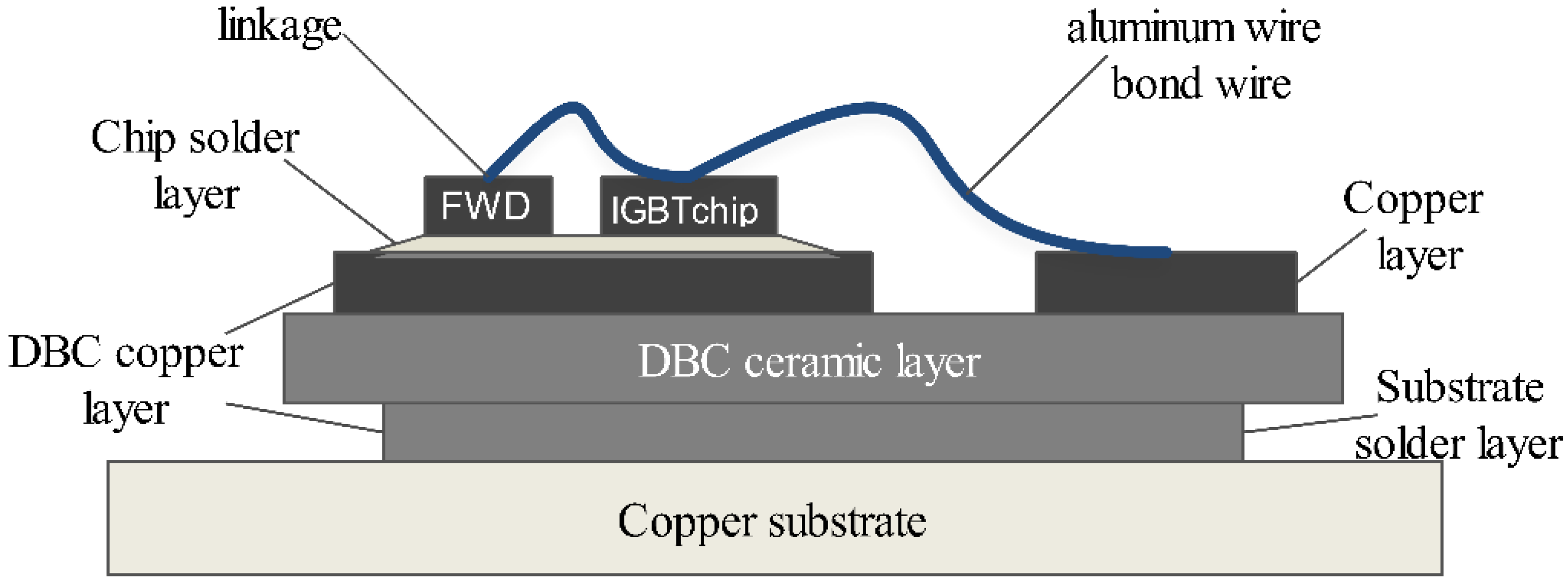
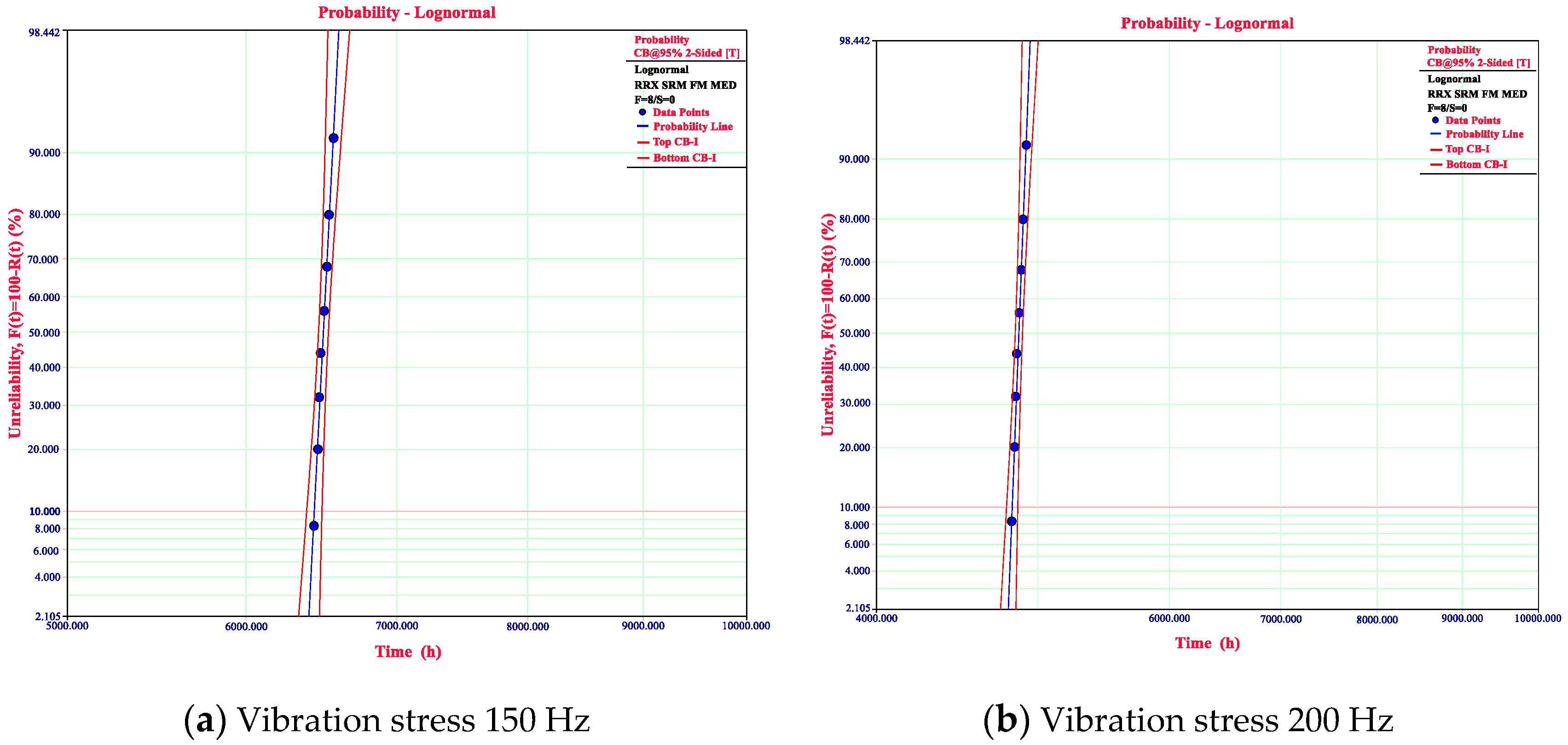
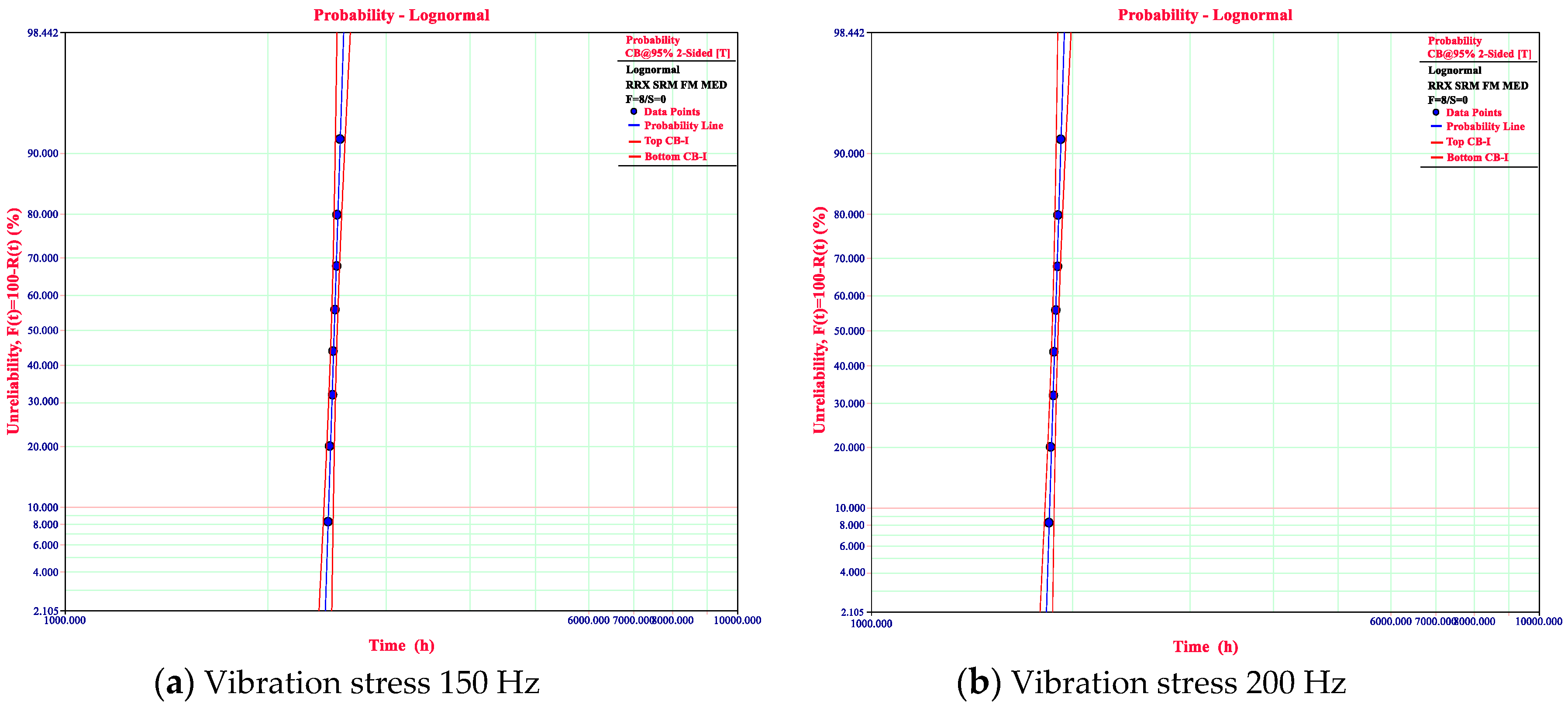
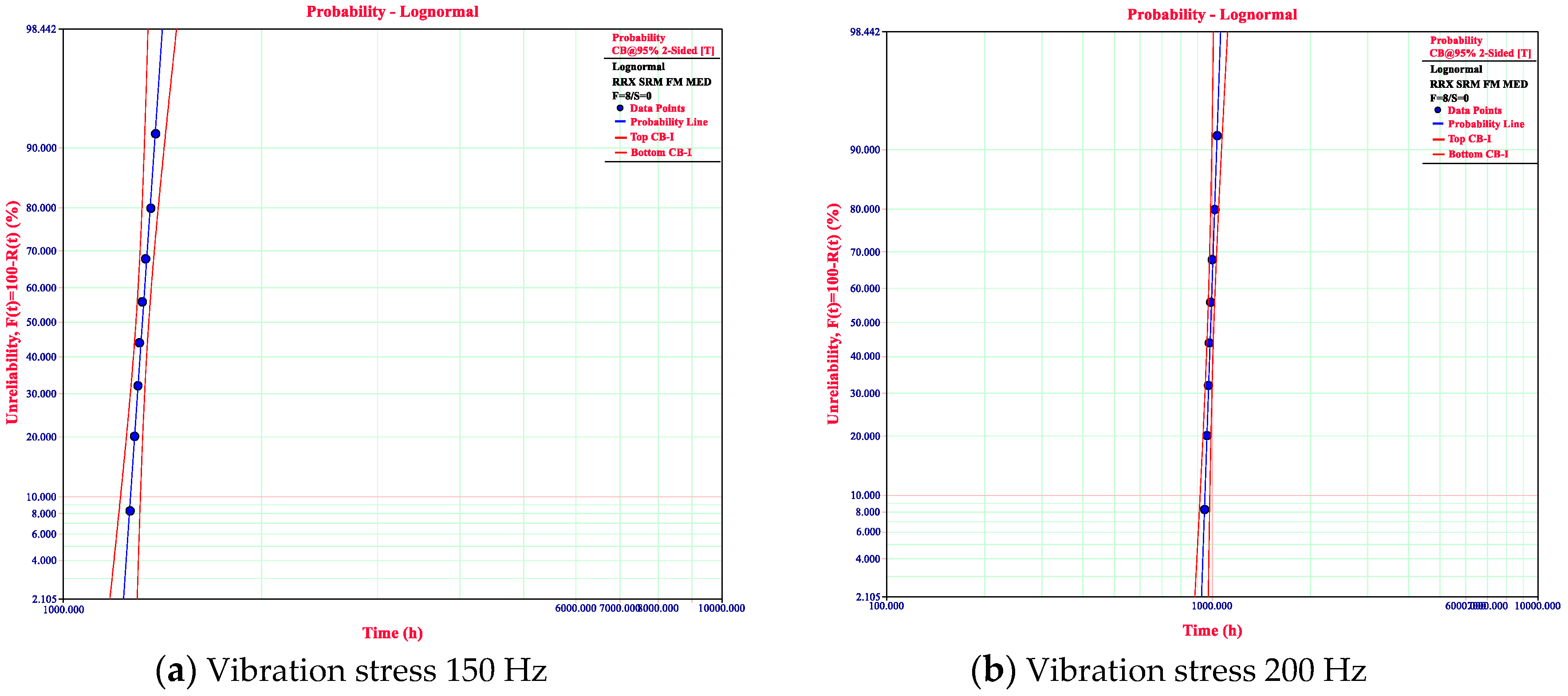
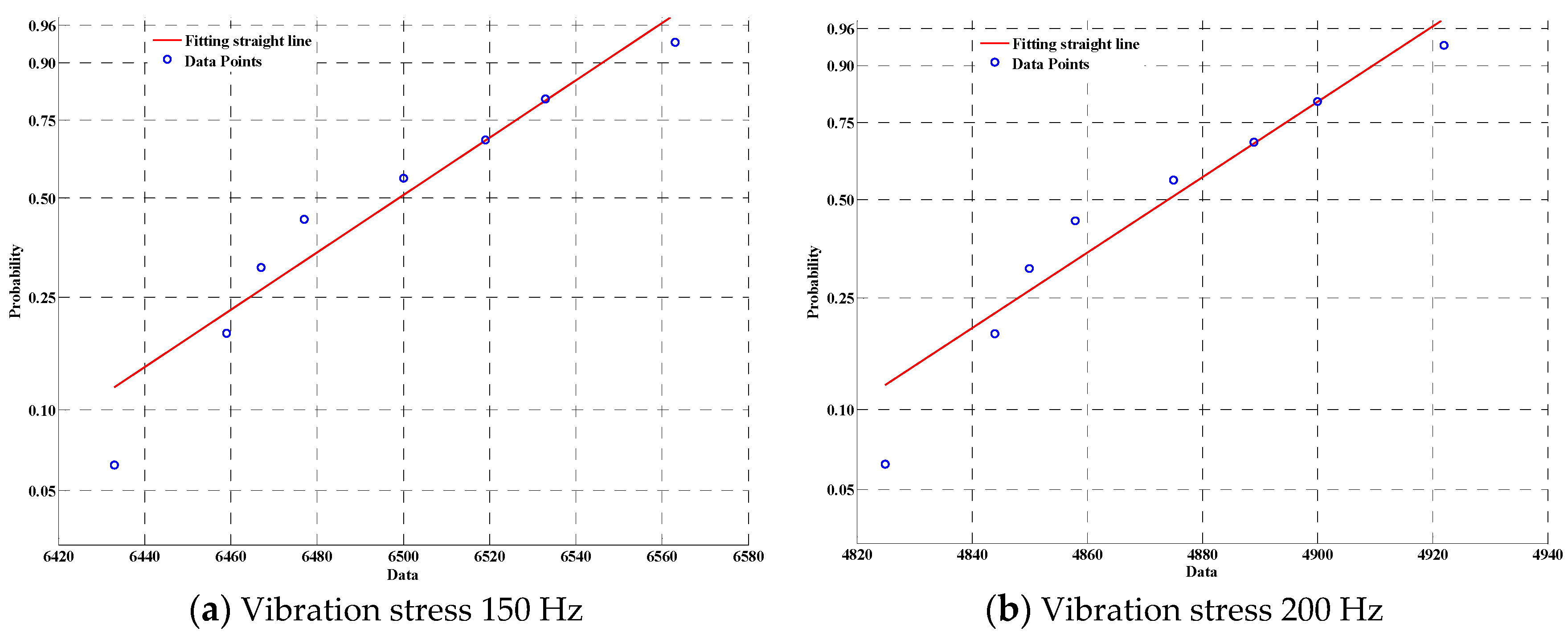
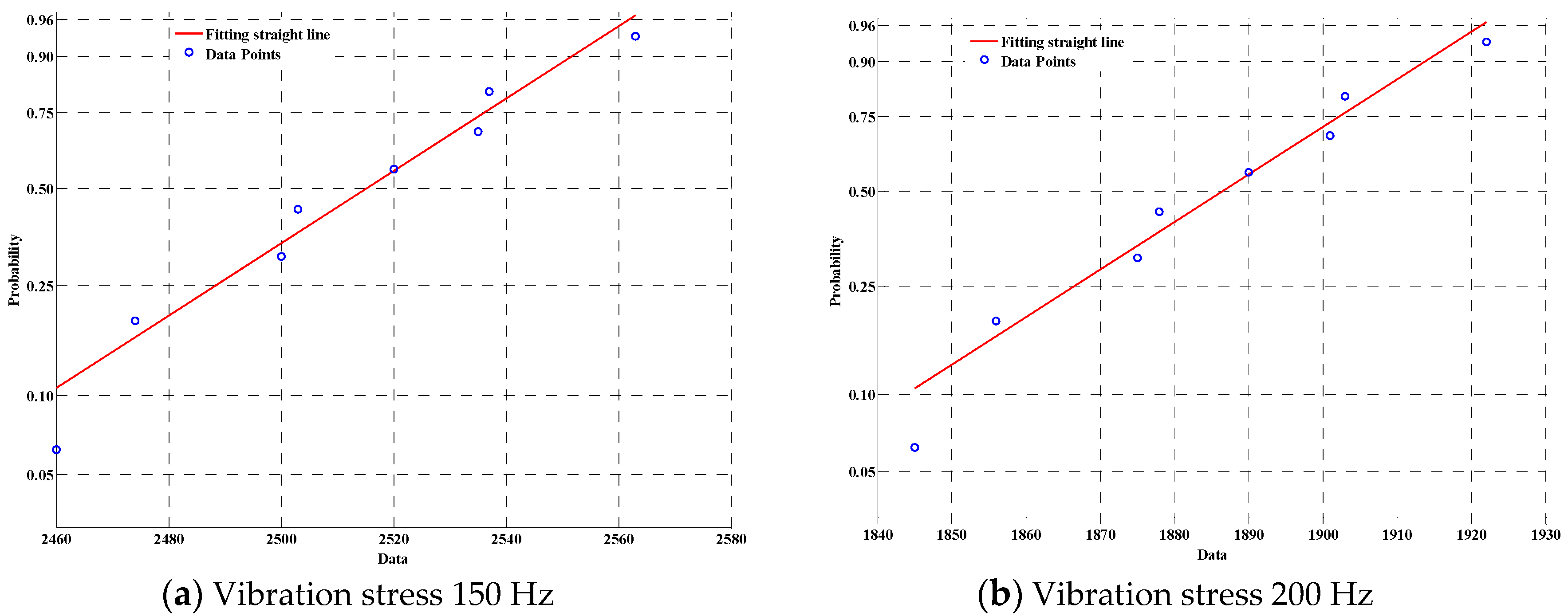
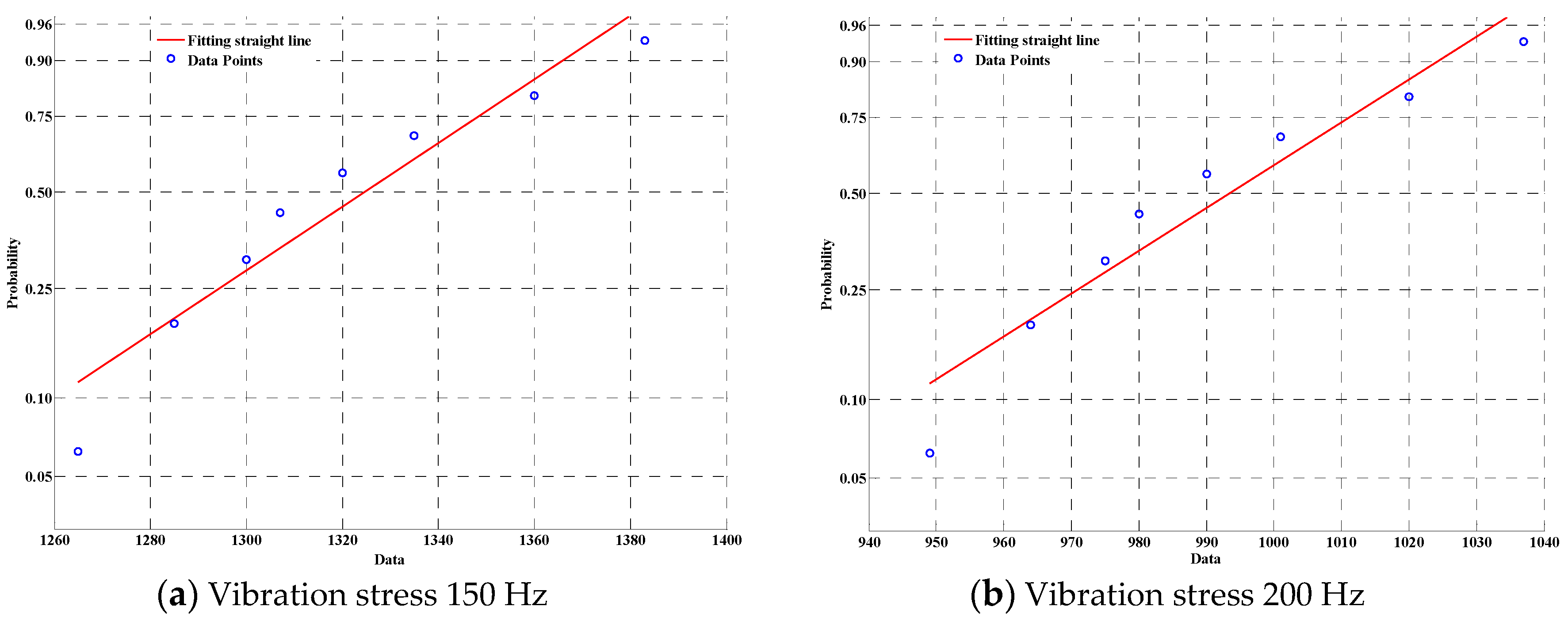
| Hierarchies | Material | Thickness /μm | Expansion Coefficient /10−6 K | |||
|---|---|---|---|---|---|---|
| IGBT chip | Si | 320 | 3.0 | 80~150 | 0.05 | 0.05 |
| Solder layer (between chip and copper layer) | SnAgCu | 80 | 25.0 | 35 | 0.02 | 0.01 |
| Copper layer on DBC | Cu | 300 | 16.8 | 390 | 0.031 | 0.03 |
| DBC ceramic layer | Al2O3 | 700 | 4.0 | 140~170 | 0.02 | 1.19 |
| Copper layer below DBC | Cu | 300 | 16.8 | 390 | 0.031 | 0.03 |
| Solder layer (between copper layer and substrate) | Sn63Pb37 | 100 | 25.0 | 35 | 0.005 | 0.24 |
| Copper substrate | Cu | 3000 | 16.8 | 390 | 0.003 | 32.33 |
| Temperature Stress /(K) | Vibration Stress/(Hz) | Time Failed/ (h) | |||||||
|---|---|---|---|---|---|---|---|---|---|
| 70 | 150 | 6500 | 6433 | 6563 | 6519 | 6533 | 6467 | 6459 | 6477 |
| 200 | 4875 | 4825 | 4922 | 4889 | 4900 | 4850 | 4844 | 4858 | |
| 90 | 150 | 2520 | 2535 | 2563 | 2537 | 2460 | 2503 | 2474 | 2500 |
| 200 | 1890 | 1901 | 1922 | 1903 | 1845 | 1878 | 1856 | 1875 | |
| 100 | 150 | 1320 | 1360 | 1335 | 1383 | 1307 | 1300 | 1285 | 1265 |
| 200 | 990 | 1020 | 1001 | 1037 | 980 | 975 | 964 | 949 | |
| Temperature Stress (K) | Vibration Stress (Hz) | m | r | |
|---|---|---|---|---|
| 70 | 150 | 588.2 | 0.9866 | 3.14 |
| 200 | 373.7 | 0.9858 | 3.26 | |
| 90 | 150 | 196.4 | 0.9857 | 2.36 |
| 200 | 162.3 | 0.9860 | 2.67 | |
| 100 | 150 | 115.9 | 0.9856 | 2.64 |
| 200 | 89.2 | 0.9858 | 2.86 |
| Temperature Stress (K) | Vibration Stress (Hz) | W |
|---|---|---|
| 70 | 150 | 0.981 |
| 200 | 0.980 | |
| 90 | 150 | 0.974 |
| 200 | 0.975 | |
| 100 | 150 | 0.983 |
| 200 | 0.981 |
| Parameter | MLE | Covariance Matrix | |||
|---|---|---|---|---|---|
| A0 | A1 | A2 | |||
| A0 | 0.5738 | 123.2535 | −4653 | 0.0562 | −0.0256 |
| A1 | 1516.8 | −4653 | 15 | −5324 | 12.3542 |
| A2 | −2.5462 | 0.0562 | −5324 | 0.4563 | 0.0025 |
| σ | 5.1532e−5 | −0.0256 | 12.3542 | 0.0025 | 0.0132 |
| m | 0 | 1 | |||||
|---|---|---|---|---|---|---|---|
| 0.7 | 0.8 | 0.9 | 0.7 | 0.8 | 0.9 | ||
| R | |||||||
| 0.85 | 7 | 10 | 14 | 10 | 15 | 22 | |
| 0.9 | 12 | 15 | 22 | 24 | 29 | 38 | |
| 0.95 | 24 | 32 | 45 | 49 | 59 | 77 | |
© 2020 by the authors. Licensee MDPI, Basel, Switzerland. This article is an open access article distributed under the terms and conditions of the Creative Commons Attribution (CC BY) license (http://creativecommons.org/licenses/by/4.0/).
Share and Cite
Wu, H.; Ye, C.; Zhang, Y.; Nie, J.; Kuang, Y.; Li, Z. Remaining Useful Life Prediction of an IGBT Module in Electric Vehicles Statistical Analysis. Symmetry 2020, 12, 1325. https://doi.org/10.3390/sym12081325
Wu H, Ye C, Zhang Y, Nie J, Kuang Y, Li Z. Remaining Useful Life Prediction of an IGBT Module in Electric Vehicles Statistical Analysis. Symmetry. 2020; 12(8):1325. https://doi.org/10.3390/sym12081325
Chicago/Turabian StyleWu, Huawei, Congjin Ye, Yuanjin Zhang, Jingquan Nie, Yong Kuang, and Zhixiong Li. 2020. "Remaining Useful Life Prediction of an IGBT Module in Electric Vehicles Statistical Analysis" Symmetry 12, no. 8: 1325. https://doi.org/10.3390/sym12081325
APA StyleWu, H., Ye, C., Zhang, Y., Nie, J., Kuang, Y., & Li, Z. (2020). Remaining Useful Life Prediction of an IGBT Module in Electric Vehicles Statistical Analysis. Symmetry, 12(8), 1325. https://doi.org/10.3390/sym12081325





